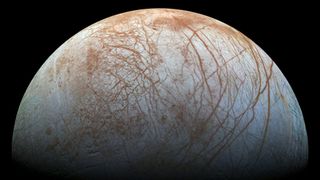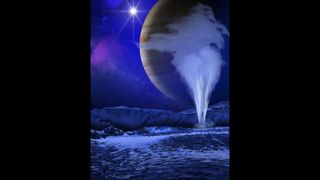Europa Clipper may be able to spot shallow lakes that erupt icy 'lava'

Salty water lakes throughout the crust of Jupiter's icy moon Europa might burst from the surface as plumes of vapor or flows of slushy ice "lava", new research suggests.
NASA's Europa Clipper will explore the moon in the early 2030s and should be able to detect these subsurface lakes, if they indeed exist. Their presence would mean that the global ocean scientists think exists below the surface of the Jovian moon isn't the only liquid water lurking under Europa's icy shell. Scientists are keen to investigate Europa and its liquid water because this moon of Jupiter appears tantalizingly capable of hosting life.
The Europa Clipper spacecraft, set to launch in 2024, will fly past Europa around 50 times using sophisticated instruments to collect data about the moon. But before the mission gets underway, scientists are working to better model the water on Europa to more accurately focus the spacecraft's investigation.
Related: Juno photos reveal more stunning glimpses of Jupiter's ice-covered moon Europa
One piece of new research in that vein offers new theories about the material that erupts from the surface of Europa as plumes or as "cryolava," the icy equivalent of the molten lava in volcanic activity seen on Earth. The work uses a new computer model and suggests that these eruptions may originate from subsurface reservoirs of salty water or "lakes" in the crust of Europa, rather than from its global liquid ocean.
"We demonstrated that plumes or cryolava flows could mean there are shallow liquid reservoirs below, which Europa Clipper would be able to detect," Elodie Lesage, lead author of the research and a Europa scientist at NASA's Jet Propulsion Laboratory (JPL) in California, said in a statement. "Our results give new insights into how deep the water might be that's driving surface activity, including plumes. And the water should be shallow enough that it can be detected by multiple Europa Clipper instruments."
The team's models suggest that the mission should detect reservoirs of water relatively close to the surface of Europa, in the upper 2.5 to 5 miles (4 to 8 kilometers) of the crust.
Get the Space.com Newsletter
Breaking space news, the latest updates on rocket launches, skywatching events and more!
This is the region where the ice is at its coldest and most brittle. Pockets of water held here would freeze and expand, thus breaking the surrounding ice and triggering an eruption. This phenomenon is similar to how carbonated drinks can swell and burst when placed in a freezer.

The researchers also determined that the reservoirs most likely to erupt in this way are wide and flat, like a pancake.
However, the situation is different deeper inside Europa, according to the team. Reservoirs below around 5 miles (8 kilometers) under Europa's crust would also expand and push on surrounding ice. But because this ice is warmer, it is less brittle and thus soft enough to absorb the increased pressure rather than bursting. Instead of being analogous to an exploding soda can, this is more like a balloon of water that stretches as the liquid it contains freezes and expands.
These findings should help the Europa Clipper's radar instrument, called Radar for Europa Assessment and Sounding: Ocean to Near-surface (REASON), hunt for pockets of water when the spacecraft arrives at Europa in 2030.
"The new work shows that water bodies in the shallow subsurface could be unstable if stresses exceed the strength of the ice and could be associated with plumes rising above the surface," Don Blankenship, leader of the REASON team and a geophysicist at the University of Texas Institute for Geophysics in Texas who wasn't involved in the research, said in the same statement. "That means REASON could be able to see water bodies in the same places that you see plumes."
The team's work is discussed in a paper published in July in The Planetary Science Journal.
Follow us on Twitter @Spacedotcom and on Facebook.
Join our Space Forums to keep talking space on the latest missions, night sky and more! And if you have a news tip, correction or comment, let us know at: community@space.com.

Robert Lea is a science journalist in the U.K. whose articles have been published in Physics World, New Scientist, Astronomy Magazine, All About Space, Newsweek and ZME Science. He also writes about science communication for Elsevier and the European Journal of Physics. Rob holds a bachelor of science degree in physics and astronomy from the U.K.’s Open University. Follow him on Twitter @sciencef1rst.
